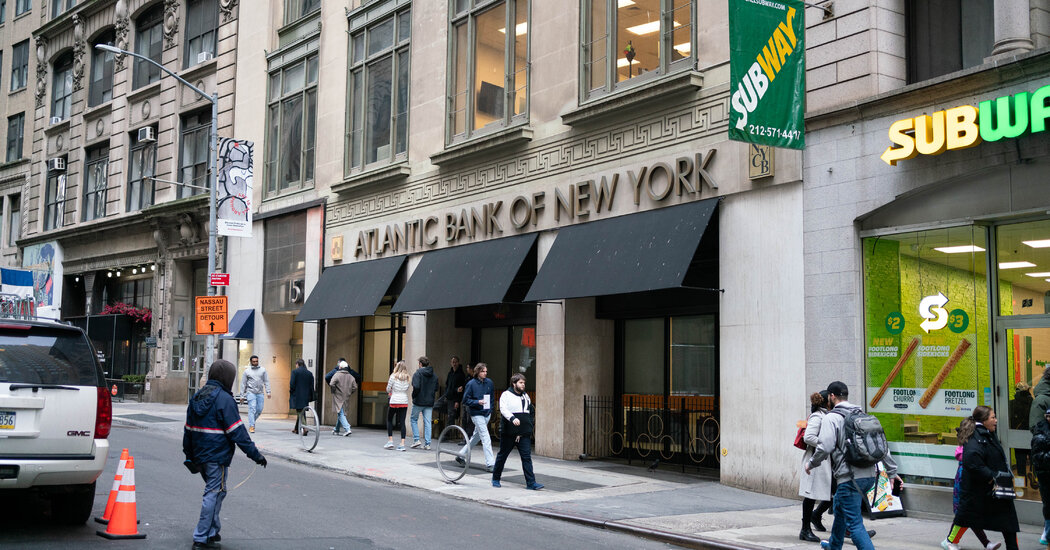Shares of New York Community Bank slid more than 25 percent on Friday, a day after the lender said its loss in the fourth quarter was $2.4 billion more than it had previously reported, and also announced the departure of its chief executive and a board member.
Shares of other regional banks were also lower: Valley National Bank and Columbia Banking System both fell more than 2 percent. The KBW Regional Bank Index, which tracks performance of U.S. regional banks, fell more than 1 percent.
The drop in shares of other banks is a sign investors are still nervous about the potential for wider trouble in the banking sector — nearly a year after several small banks failed. But the fact that the declines in other regional banks were small suggested that NYCB’s problems are seen as unique to it.
“The market is made nervous because of what we lived through last year,” said Christopher Marinac, an analyst and director of research at Janney Montgomery Scott, a financial services firm.
What put NYCB at risk?
NYCB had appeared to be one of the winners of last year’s regional banking crisis, after it acquired most of the assets to Signature Bank, which collapsed, along with Silicon Valley Bank and First Republic Bank.
The acquisition helped NYCB’s grow to more than $100 billion in assets, but it also subjected it to more regulatory scrutiny, which meant it had to increase its reserves, and quickly.
NYCB said the bigger loss reported on Thursday was a $2.4 billion hit in what is known as goodwill, essentially a catchall financial category that companies of all types use to describes assets that cannot be easily valued or sold. NYCB did not provide details on the reason for that impairment.
The current crisis at NYCB is a consequence of how regulators responded a year ago, when they “inexplicably approved multiple rapid-fire mergers,” said Dennis M. Kelleher, the president and chief executive of Better Markets, a group that seeks stronger bank regulations.
How does this affect consumers?
NYCB, which is based in Hicksville, N.Y., has a national presence, partly because of its acquisition of Signature Bank’s assets, and operates more than 400 branches under brands including Flagstar Bank and Atlantic Bank of New York. Flagstar is one of the nation’s largest residential mortgage servicers, exposing the bank to weaknesses in the housing market, particularly in a time with persistently high interest rates.
When Silicon Valley Bank collapsed last March, fears mounted of a wider run on banks that could have threatened the sector like during the 2008 financial crisis. The health of banks like NYCB, a large lender in the New York area, is closely monitored.
Though investors reacted strongly to the news on Thursday, customers should be less concerned about their accounts and insuring their deposits. Each depositor is protected with government insurance up to $250,000.
The bank said on Feb. 6 it had $10 billion set aside to offer customers expanded deposit insurance, and that insured and collateralized deposits represent more than 70 percent of all deposits. The company still has strong liquidity and deposits, which at $83 billion as of Feb. 5 were higher than at the end of 2023.
The investor reaction on Friday is the latest sign that regional banks are struggling to move on from last year’s crisis. Regional banks like NYCB are more exposed to commercial real estate than larger banks, and high vacancy rates in office buildings after the rise and staying power of remote work have helped drive down the value of commercial real estate. That floundering market has been a key driver of NYCB’s most recent woes, which have been exacerbated by high interest rates.
Where does NYCB go from here?
NYCB still faces a difficult financial and regulatory environment. It could raise capital by selling assets or choosing not to refinance some loans, writing them off as losses. Raising capital would help NYCB better meet regulatory requirements, but it would also give it the chance to diversify beyond real estate.
The adjustment is part of the growing pains the bank has to go through as it adapts to a new regulatory environment, with agencies like the Federal Deposit Insurance Corporation and the Office of the Comptroller of the Currency taking a harder look at regional banks since last year’s crisis, Mr. Marinac said.
“It’s a transition that’s been fumbled, but it can still be successful,” he said.




